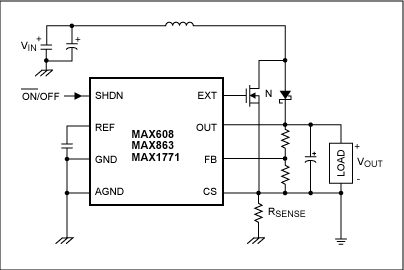Circuit Connection Adds Current-Mode Operation to PFM Boost Converters
要約
Analog Devices' PFM boost controllers offer high efficiency and low quiescent current; however, by externally adding a current mode signal into the feedback, the stability and output ripple are improved. This circuit connection requires no additional ICs or components versus the standard connection.
A control scheme used in certain boost-controller ICs from Analog Devices (current-limited pulse-frequency modulation, or PFM), achieves high efficiency over a wide range of output current by combining the low quiescent current of PFM with the load-driving capability of pulse-width modulation (PWM). To provide current-mode control as well, simply connect the load, output filter capacitor, and lower feedback resistor to the current-sense pin (CS) instead of ground (Figure 1).

Figure 1. This circuit adds current-mode operation to Analog Devices' current-limited PFM boost controllers without increasing the quiescent current.
When operating with medium to heavy loads, the Figure 1 circuit exhibits lower output ripple and a more stable inductor current (Figure 2a) than do the standard application circuits represented by typical waveforms in Figure 2b. The improvements gained by these connections have no effect on the quiescent current and require no additional circuitry, but they do require separate input and output grounds as shown, connected only by RSENSE.

Figure 2. The Figure 1 circuit's inductor-current and output-ripple waveforms (a) exhibit better stability and lower ripple amplitude than those of the standard operating configuration (b).
This circuit achieves current-mode control by constantly monitoring the inductor current through RSENSE: via the field-effect transistor during tON (which depends on the magnitude of VIN), and via the diode and output filter capacitor during tOFF (minimum 2.3µs). Flowing through RSENSE, the inductor current creates a signal at CS that couples through the output filter capacitor and adds to the normal feedback signal at FB. Connecting the load between OUT and CS prevents this CS signal from adding to the ripple at VOUT.